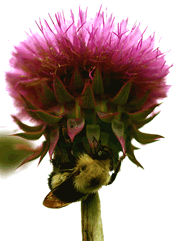 Milk
thistle (Silybum marianum) has an extensive history of
use as a remedy for liver problems in both Eastern and Western
traditional medicine. Silymarin is a flavonoid comprised of
a mix of milk thistle components including silibinin. Most silymarin
studies have looked at its effect on liver fibrosis, but in
recent years researchers have studied its direct activity against
HCV in the laboratory and in vivo.
Milk
thistle (Silybum marianum) has an extensive history of
use as a remedy for liver problems in both Eastern and Western
traditional medicine. Silymarin is a flavonoid comprised of
a mix of milk thistle components including silibinin. Most silymarin
studies have looked at its effect on liver fibrosis, but in
recent years researchers have studied its direct activity against
HCV in the laboratory and in vivo.
A survey
of participants in the HALT-C trial -- which evaluated the
benefits of long-term pegylated interferon for patients who
did not respond to standard treatment with pegylated interferon
plus ribavirin -- found that participants who said they used
silymarin did not have lower HCV viral load on average than
non-users. Another
recent study, however, showed that silymarin inhibited activity
of the HCV polymerase, which copies viral genetic material as
part of replication.
In the present study, Jessica Wagoner from the University of
Washington in Seattle and colleagues further characterized the
antiviral action of silymarin in the laboratory.
Results
 |
Silymarin
had antiviral effects against HCV in cell cultures, including
inhibition of virus entry into cells, HCV RNA and protein
expression, and production of infectious virus particles. |
 |
Silymarin
did not block HCV binding to cells, but did inhibit entry
of viral pseudoparticles and fusion of HCV pseudoparticles
with liposomes, or fat bubbles. |
 |
Silymarin
-- but not silibinin -- inhibited activity of the HCV genotype
2a NS5B RNA-dependent RNA polymerase at concentrations 5-10
times higher than required for an anti-HCV effect in cell
culture. |
 |
Silymarin
had only minimal activity against genotype 1b isolate BK
and 4 genotype 1b polymerases derived from HCV-infected
patients, however. |
 |
Silymarin
did not inhibit HCV replication in 5 independent genotype
1a, 1b, and 2a replicon model cell lines that did not produce
infectious virus. |
 |
Silymarin
inhibited microsomal triglyceride transfer protein activity,
apolipoprotein B secretion, and infectious virion production
in cell culture medium. |
 |
Silymarin
also blocked cell-to-cell spread of HCV. |
Based
on these findings, the study authors concluded, "Although
inhibition of in vitro NS5B polymerase activity is demonstrable,
the mechanisms of silymarin's antiviral action appear to include
blocking of virus entry and transmission, possibly by targeting
the host cell."
Investigator affiliations: Departments of Laboratory Medicine,
Microbiology, and Global Health, University of Washington, Seattle,
WA; Center for Engineering in Medicine, Massachusetts General
Hospital, Boston, MA; Department of Pediatrics, University of
Texas Medical Branch, Galveston, TX; School of Medicine, University
of Texas Southwestern Medical Center, Dallas, TX; Hepatitis
C Virus Research Group, Institute of Biomedical Research, University
of Birmingham, Birmingham, UK; Institut de Biologie et Chimie
des Protéines, Université Lyon 1, IFR128 Lyon
Biosciences Gerland, CNRS-Universite Claude Bernard, Lyon, France;
Department of Chemistry and Biochemistry, University of North
Carolina at Greensboro, Greensboro, NC; Department of Molecular
Virology, University of Heidelberg, Heidelberg, Germany; Department
of Molecular Microbiology and Immunology, Saint Louis University
School of Medicine, St. Louis, MO.
8/20/10
Reference
J Wagoner, A Negash, OJ Kane, and others. Multiple effects of
silymarin on the hepatitis C virus lifecycle. Hepatology
51(6): 1912-1921 (Abstract).
June 2010.
